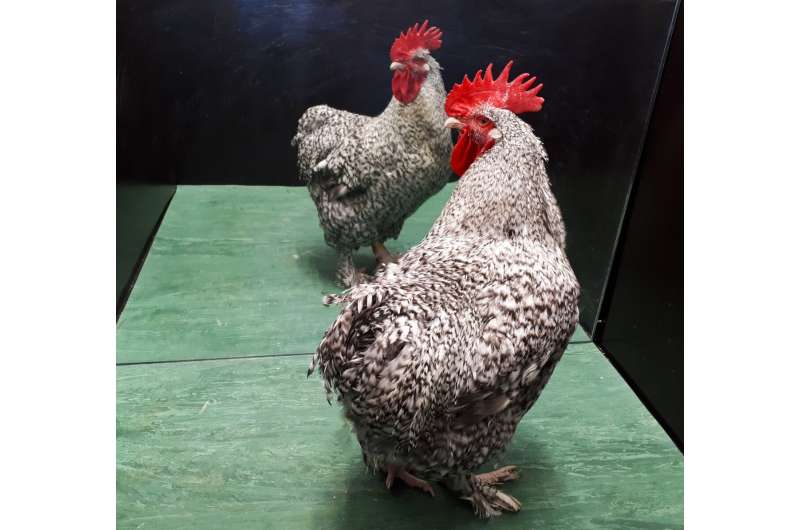October 26, 2023 report
This article has been reviewed according to Science X's editorial process and policies. Editors have highlighted the following attributes while ensuring the content's credibility:
fact-checked
peer-reviewed publication
trusted source
proofread
Roosters may have passed the self-recognition test

A team of neuroscientists and psychologists from the Institute of Agricultural Engineering at the University of Bonn, and the Institute of Cognitive Neuroscience at the University of Bochum, both in Germany, has found possible evidence of roosters passing the self-recognition test. In their paper published in the open-access journal PLOS ONE, the group describes experiments they conducted with roosters and mirrors.
Prior research has suggested that very few animal species have the type of self-awareness known as self-recognition—where they see and understand that an image in a mirror is of themselves rather than another member of the same species. Multiple experiments have been conducted to determine self-recognition that involve observing whether an animal responds to a mark on its face or body upon seeing it in a mirror. This has revealed that some animals appear to have self-recognition, including magpies, some apes, elephants and dolphins.
In this new effort, the research team noted that many animals do not have arms, hands or fingers that could be used to respond to a mark on a part of the body if noticed in a mirror—so they came up with a new way to test whether an animal is able to self-recognize and they tested the idea on roosters.
Prior research has shown that roosters tend to crow not just when the sun comes up but also when they spy a predator. When alone and unbothered, they tend to remain quiet. They researchers took advantage of this trait during the self-recognition experiments they devised.
The experiments involved placing a single rooster in a small arena that was divided in half by a wire mesh. On the other side of the mesh, they placed another rooster for some trials and left it empty for others. They also affixed a mirror to the mesh for some trials that prevented the rooster from seeing if there was another rooster on the other side. For some trials, they also added a threat by beaming the silhouette of a hawk moving across the ceiling.
In watching and recording the behavior of the rooster, the research team found that it was much more likely to crow when it knew there was another rooster on the other side of the mesh—and it did so regardless of whether it could see itself in the mirror or not—a sign that it did not think the reflection in the mirror was of another rooster. It also suggested that roosters determine if something (such as a reflection) is real or not based on vision, not by sounds or smells.
More information: Sonja Hillemacher et al, Roosters do not warn the bird in the mirror: The cognitive ecology of mirror self-recognition, PLOS ONE (2023). DOI: 10.1371/journal.pone.0291416
Journal information: PLoS ONE
© 2023 Science X Network




















